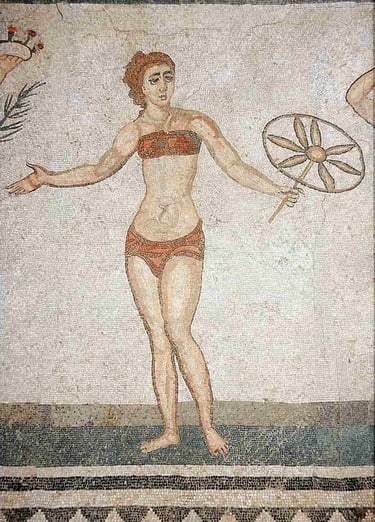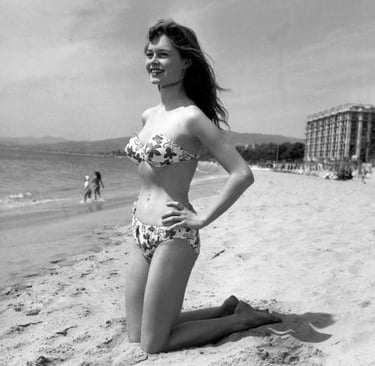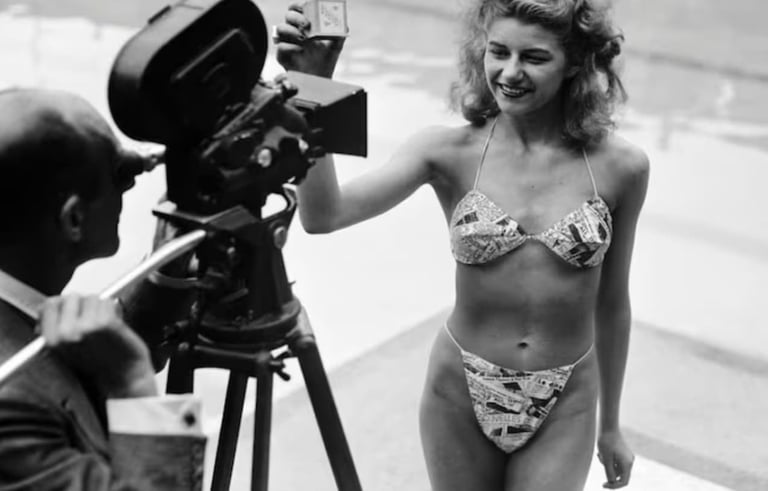The Bikini’s Bold Evolution: From Shocking Debut to Global Icon
From its daring debut in 1946 to becoming a timeless icon of confidence and freedom, discover the captivating journey of the bikini.
3/4/20256 min read


The Fascinating Evolution of the Bikini: A History of Liberation and Fashion
The bikini is no ordinary piece of clothing. It has evolved from a controversial, shocking garment to an iconic symbol of freedom, beauty, and empowerment. Today, it is found in nearly every wardrobe and is a staple of beachwear across the globe. But its history is anything but simple. The journey of the bikini spans centuries of fashion, cultural shifts, and social change, making its story a remarkable one.
The Ancient Roots of the Bikini
Long before Louis Réard revolutionized swimwear, ancient civilizations were already experimenting with two-piece garments. In ancient Greece and Rome, depictions of women in attire resembling bikinis can be found in art, including frescoes and sculptures. These garments, worn by women for athletic events or leisure, were a far cry from today’s bikini in design, but they laid the groundwork for the garment's future reimagining.
The 1940s: A Shocking Debut
The modern bikini, however, is often credited to French designer Louis Réard, who unveiled the bikini in 1946. Named after the Bikini Atoll in the Pacific Ocean — site of U.S. nuclear tests — Réard’s creation was as explosive as its namesake. At a time when modesty was the norm, the bikini was a revolutionary garment. It was small, daring, and left little to the imagination. Comprised of just two triangles of fabric for the top and bottom, the bikini caused a stir in both the fashion world and society.
Réard faced difficulty in finding a model willing to wear his creation, as it was considered too scandalous. Eventually, he found Michelle Bernardini, a dancer at the Casino de Paris, to wear the first-ever bikini on a runway. The world was shocked, and many refused to accept this daring new piece of swimwear. Even mainstream fashion houses were initially skeptical.
The 1950s: A Slow Acceptance
While the bikini was controversial in its early years, the 1950s saw its gradual acceptance into mainstream fashion. The bikini gained visibility through high-profile figures like Brigitte Bardot and Marilyn Monroe, both of whom became symbols of beauty and sensuality. Bardot, in particular, helped popularize the bikini when she wore one on the beach in the 1952 film And God Created Woman. As the media spotlight on these iconic women grew, so did the allure of the bikini.
By the end of the decade, the bikini was no longer just a novelty. It became a symbol of sexual liberation and freedom, an emblem of youthful confidence. However, despite this growing popularity, the bikini still faced significant resistance from conservative groups who saw it as immoral or improper.
The 1960s-1970s: The Rise of the Sexual Revolution
The 1960s was a decade of profound cultural change, and the bikini evolved alongside it. The sexual revolution, which encouraged more open conversations about sexuality and personal freedom, had a profound influence on fashion. The bikini, once considered an outrageous garment, came to symbolize the growing sense of independence and sexual autonomy.
A key moment in the bikini's history came in 1962 when Ursula Andress wore a white bikini in the James Bond film Dr. No. Her iconic emergence from the water, as she played the role of "Honey Ryder," captured the imagination of millions and cemented the bikini's place in popular culture. The film's global success propelled the bikini from a controversial garment to a mainstream fashion statement.
During the 1960s and 1970s, fashion designers began to experiment with different styles and cuts. The bikini moved beyond the basic two-piece design, with new variations emerging, such as the monokini, created by designer Rudi Gernreich in 1964. The monokini, a topless swimsuit, was a further challenge to traditional notions of modesty and gender roles
The 1980s-1990s: Global Phenomenon and Pop Culture
By the 1980s, the bikini had transformed from an object of controversy to a mainstream phenomenon. The arrival of the Baywatch TV show in the 1990s, with its iconic red bikinis, helped cement the bikini as a symbol of athleticism, beauty, and the sun-soaked lifestyle. Supermodels like Cindy Crawford, Elle Macpherson, and Tyra Banks showcased the bikini in their swimsuit ads, fueling the global obsession with beach culture and making the bikini a ubiquitous symbol of beauty and glamour.
Throughout the 1980s and 1990s, bikini styles exploded, from high-cut swimsuits to string bikinis. The bikini became more than just beachwear; it became a global fashion trend, appearing in magazine spreads, films, and advertisements. Its status as a symbol of the female form, often sexualized but also empowering, made it both a product of the times and a reflection of the shifting societal views on body image.
The 2000s-Present: Inclusivity and Innovation
The 21st century saw the bikini continue to evolve in both design and representation. As discussions about body positivity gained prominence, the bikini also began to be embraced in a wider array of styles, cuts, and sizes, catering to women of all body types. This new wave of inclusivity helped diversify the image of the bikini, from the ultra-slim model to the fuller-figured woman, helping to challenge traditional standards of beauty.
Sustainability also became an important issue in fashion, including swimwear. Designers began creating eco-friendly bikinis made from recycled materials, like ocean plastic, helping to make the fashion industry more conscious of its environmental impact. Innovation in fabric, cut, and style flourished, and brands began to offer more personalized options to suit individual preferences.
Brazil's Influence: The Rise of the Brazilian Bikini
In Brazil, the bikini made its debut in the late 1940s. The first public appearance of the bikini in Brazil took place in 1948, with model Miriam Etz. Gradually, the swimsuit began to appear on the country’s beaches. Helô Pinheiro, the muse behind the classic song "Garota de Ipanema" ("The Girl from Ipanema"), was one of the first to embrace the piece. With Brazil's globally famous beach culture, the bikini quickly became a symbol of the Brazilian way of life. Brazilian women were at the forefront of creating and popularizing new, smaller cuts and designs, turning the Brazilian bikini into a style known for its boldness and sensuality. We’ll dive deeper into how the Brazilian bikini became a global reference in another post.
The Bikini Today: A Symbol of Empowerment
The bikini today is not just a piece of clothing; it is a symbol of empowerment and body autonomy. It embodies personal freedom and self-expression, allowing women (and men) to showcase their individuality. Whether it’s a simple, classic design or a cutting-edge, sustainable creation, the bikini has evolved into a garment that represents choice, confidence, and liberation.
Conclusion: A Legacy of Rebellion and Freedom
From its humble, scandalous beginnings to its present-day status as a cultural icon, the history of the bikini is a testament to the power of fashion to influence societal norms and challenge conventions. It reflects the ongoing dialogue between the individual and society, as well as the shifting tides of cultural attitudes toward modesty, sexuality, and personal identity.
The bikini is more than just swimwear. It is a symbol of changing times, a fashion revolution, and an emblem of freedom. Its journey, from an explosive new design to a global staple, is one that mirrors the evolution of our attitudes toward beauty, self-expression, and empowerment. It stands as a lasting reminder of the power of fashion to transform not only what we wear but also how we perceive ourselves and the world around us.


Goddess Venus! | Image: Reproduction/Andreas Wahra






Michelle Bernardini. Picture taken July 5, 1946, at the Molitor pool in Paris of a candidate for a beauty contest wearing a bikini by Louis Réard. (Reuters)
Interestingly, while Louis Réard's creation is considered the first modern bikini, archaeological evidence shows similar garments were worn in ancient times. In Italy, depictions of the goddess Venus in a bikini-like garment suggest the concept has been part of the collective imagination for centuries!
Brigitte Bardot was one of the first Hollywood icons to don the string bikini. (LIDO/SIPA)
© 2025. All rights reserved.
Get Help
About
Blog
